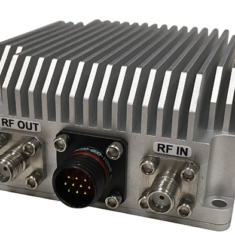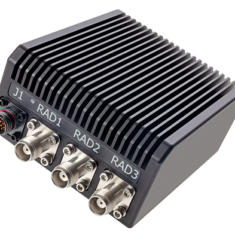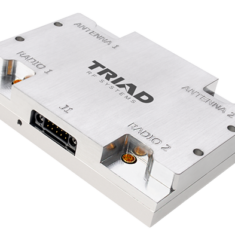RF amplifiers are electronic devices used to convert a signal in the radio frequency portion of the electromagnetic spectrum to a signal with a higher amplitude. Radio frequency signals are used by drones and other unmanned systems for command and control, communications and telemetry, and transferring data from payloads such as cameras and other sensors.
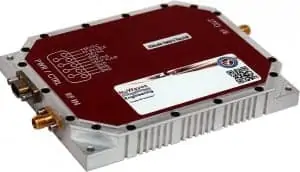
NuWaves-S-Band-Power-Amplifier
Many radio frequency amplifiers can be grouped into different classes, labelled from A to F, that signify different modes of operation. Different classes are used for different design goals, depending on desired characteristics such as gain, power output, bandwidth, efficiency, linearity and impedance matching.
Drone Signal Boosters
RF power amplifiers boost the power of a signal before it is delivered to the antenna of the transmitter, giving the signal sufficient strength to travel the distance required once transmitted. This is particularly important for UAVs that fly long distances and need to maintain a constant high-rate communications link. Power amplifiers and signal boosters must have sufficient gain to be able to amplify the signal to the level required by the antenna.
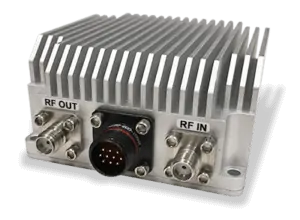
RF Power Amplifier by Triad RF Systems
An important property of RF power amplifiers is linearity, which is a measure of how little the amplifier distorts a signal. High linearity is particularly crucial for high data rate modulation techniques such as CODFM. This often comes at the cost of reduced efficiency, which is defined as the amplifier’s useful power output divided by its total power input.
Efficient RF amplifiers are important for smaller and SWaP (size, weight and power)-constrained UAVs. The effects of the tradeoff can be improved by using newer, more efficient technologies such as gallium nitride (GaN) transistors, as well as pre-distortion technologies to improve linearity.
Low-Noise & Antenna Amplifiers
Low-noise amplifiers (LNAs) are usually found at the receiving end of a radio system, between the antenna and the receiver. They amplify weak signals that have been picked up by the radio’s receive antenna, and are designed to do this without introducing too much additional noise into the signal, thus ensuring that the signal-to-noise ratio is not significantly affected.
Low-noise amplifiers help to maximise the sensitivity of a receiver, which is defined as its ability to successfully detect and process weak signals. Sensitivity is particularly important for long-range UAVs that may have to receive radio signals broadcast over great distances.
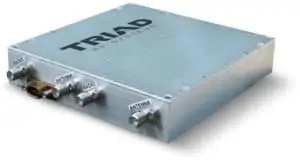
Triad Systems Bi Directional Amplifier
Bi-Directional Amplifiers
Bi-directional amplifiers combine an RF power amplifier with a low noise amplifier, thus providing a solution to extend the range for both the transmit and receive parts of a UAV data link. The rf power amplifier allows the vehicle to maintain data links over greater distances, which the low-noise amplifier provides optimized receiving of communications. Both the factors will allow the UAV to fly further.
Bi-directional amplifiers may provide half-duplex or full-duplex operation. Full-duplex allows simultaneous transmitting and receiving, whereas half-duplex only allows one at a time.






